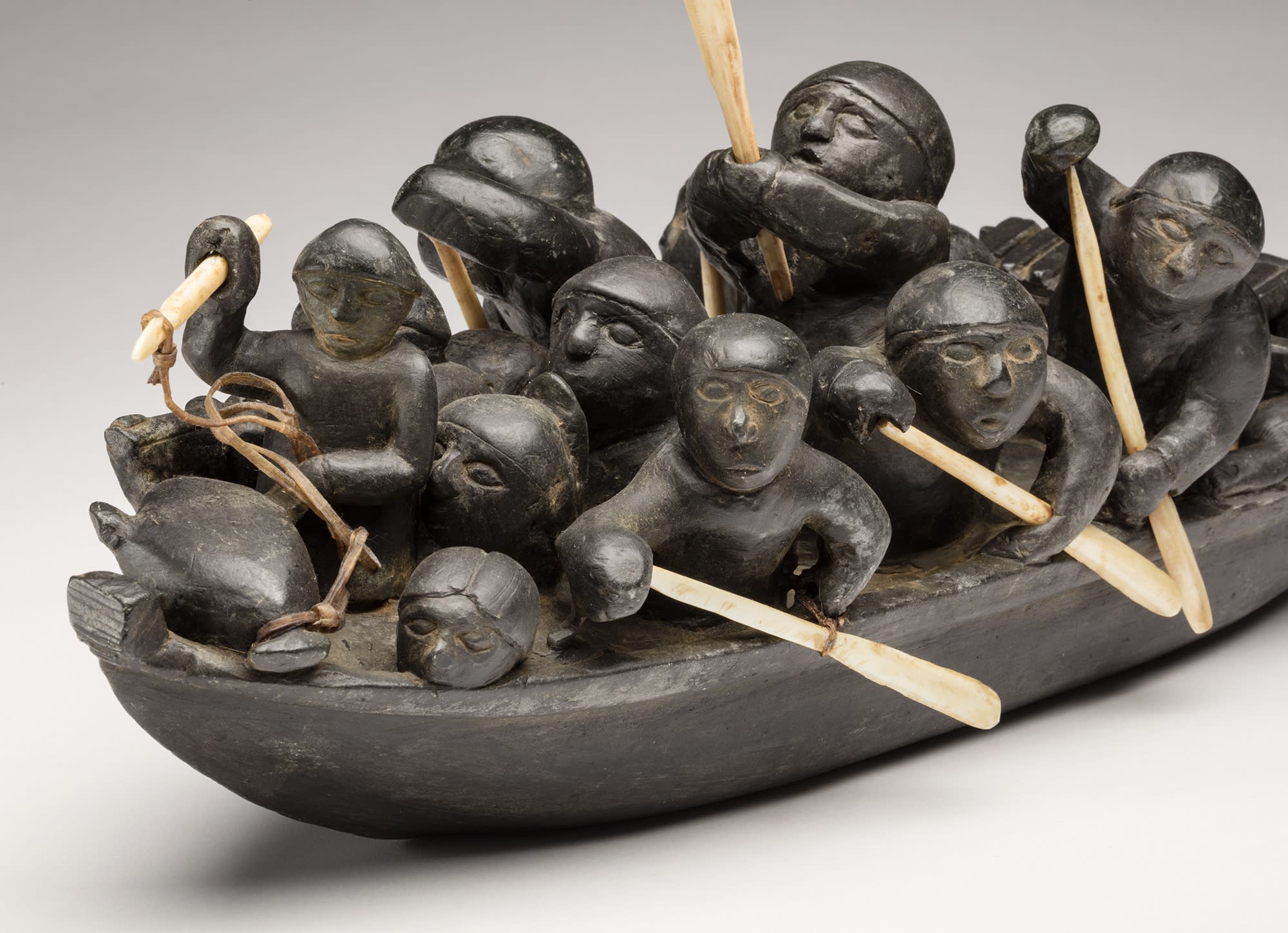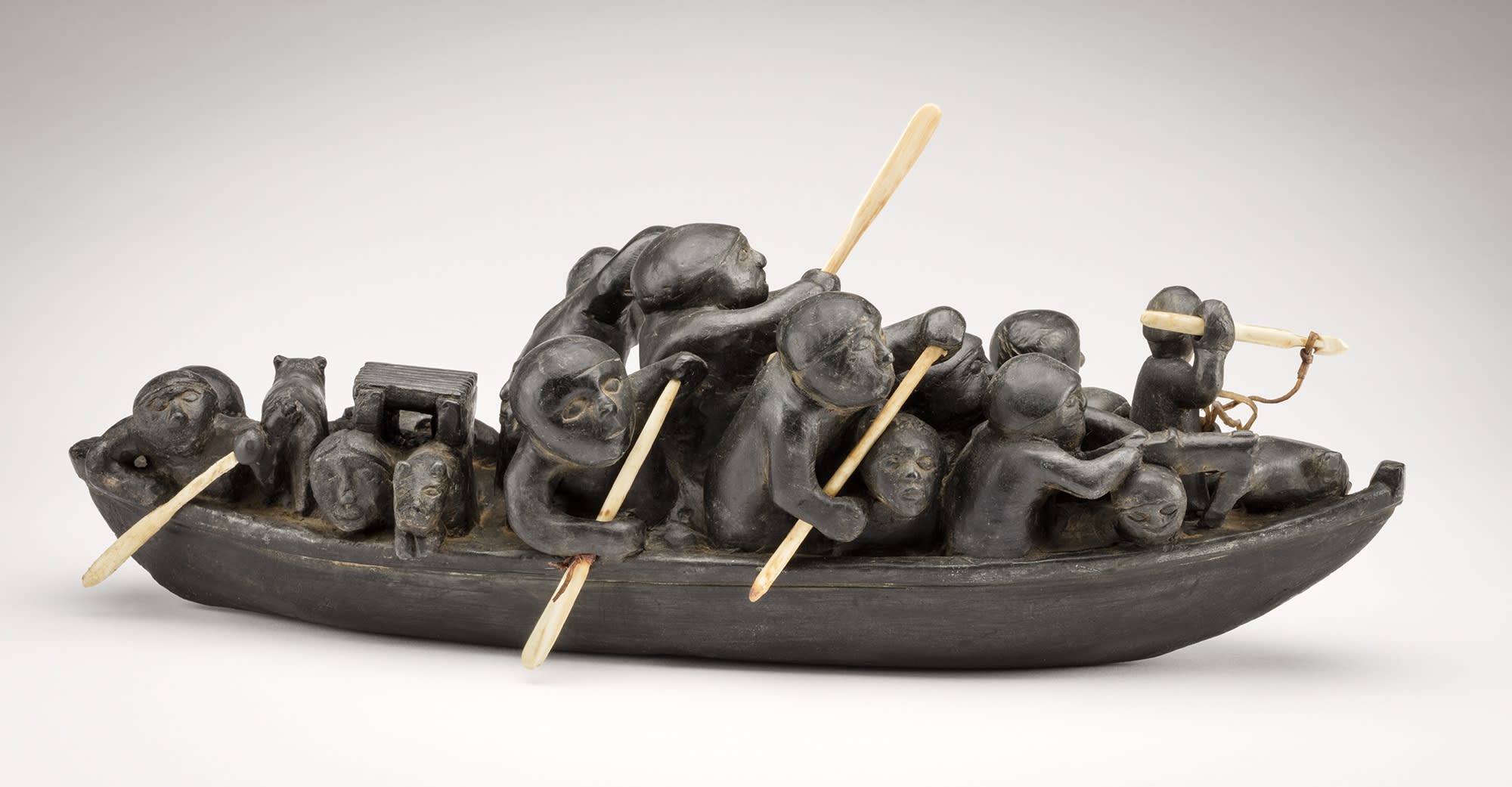Lot 32
Migration Boat, 1966
stone, ivory, and sinew, 6.5 x 16 x 5.25 in (16.5 x 40.6 x 13.3 cm)
signed and inscribed with disc number, "JOE E9818".
This highly important Migration Boat is one of the largest and most beautifully carved examples in existence. In fact, at sixteen inches in length (40.6 cm), this sculpture is one of the most imposing the artist ever created. Viewers of this work will be immediately impressed, however, not just by the sheer scale of the sculpture but also by the sense of energy and excitement evident in both the overall composition and in the figures themselves. We feel the sense of drama and urgency that is more typical of the more roughly carved, expressionistic examples made by the artist in the mid 1970s, towards the very end of his career.

It is well known that Joe Talirunili regularly changed up the details in his various versions of his “Migration” story; in a sense each version is virtually unique in its attributes. The number of occupants and the composition of the “crew” vary considerably. Several versions lack sails – interestingly, all of the migration boats in Talirunili’s drawings and prints are depicted without sails – while a few even lack paddlers. Attributes that appear here and there are rifles, harpoons, and dogs. Paper labels and folk art-style repairs are not uncommon. For a rare example with a kayak see First Arts, May 2019, Lot 18.
This outstanding sculpture depicts most of these attributes and then some – it may be that the unusually large size of this example allowed Joe to add extra features. At the bow we see a man with a rifle (referencing the part of the story in which the shaman-grandmother instructs two men to shoot at the island, allowing the boat to approach it). There is also a harpooner, and most unusually, also an avataq (sealskin float). The woman with a distinctive bun, shown directly behind the harpooner, may be the grandmother Aullajuk. Other women as well as children are included as well. While other of Joe’s boats contain dogs, we do not recall another one that includes a qamutiq and a captured seal. The boat is inscribed underneath with the artist’s first name and his disc number.
As with other fine versions of Talirunili’s famous Migration story, this sculpture surprises and delights the viewer with small touches of quirkiness and humour. We love the way one of the dogs rests its chin on its forepaws as it peers out over the gunwale of the boat, apparently as oblivious as the woman or girl next to it that there are sled runners resting on their heads. Similarly, the rifleman rather awkwardly steadies his weapon on the head of another passenger. Joe Talirunili has brilliantly imbued this magnificent sculpture with humanity and heroism.
 This Migration Boat resembles two other fine examples from the mid 1960s in several ways. The boat in the Twomey Collection at the WAG, although considerably smaller, is one of the closest stylistically to our example. In both the Twomey boat and this one, the figures – men, women, children, and dogs – are fully carved, and both have relatively few paddlers. The Twomey example sports a mast but does not include a qamutiq, seal, avataq, or harpoon. The other example, very similar in scale and also without a sail, is in the TD Bank Collection. It contains more human figures than our example; notably, they are tightly packed rather than openly carved. The TD boat, however, contains few additional attributes.
This Migration Boat resembles two other fine examples from the mid 1960s in several ways. The boat in the Twomey Collection at the WAG, although considerably smaller, is one of the closest stylistically to our example. In both the Twomey boat and this one, the figures – men, women, children, and dogs – are fully carved, and both have relatively few paddlers. The Twomey example sports a mast but does not include a qamutiq, seal, avataq, or harpoon. The other example, very similar in scale and also without a sail, is in the TD Bank Collection. It contains more human figures than our example; notably, they are tightly packed rather than openly carved. The TD boat, however, contains few additional attributes.
Provenance
Collection of Mr. Burleigh and Mrs. Anne Cowan, Winnipeg, acquired from the Hudson’s Bay Company in 1966;
by descent to the present Private Collection, Calgary.
Mr. Burleigh and Mrs. Anne Cowan began their collection in 1958 at the start of their marriage. Burleigh began his interior design career in 1957 with The Hudson’s Bay Company retail design office, then located at the corporate head office in Winnipeg. They were introduced to the carvings and prints of the northern artists through The Company’s acquisitions for their retail department, and the two of them often spent hours perusing the retail floor’s massive offerings. Anne had an artisan’s eye for the carver’s choice of stone and what forms were drawn out of the raw material, helping Burleigh decide which pieces to purchase to add yearly to their collection.
In some years, “The Company” would bring in a cross section of extraordinary pieces for the purpose of deciding which would be an appropriate gift for a visiting dignitary. The pieces not selected as gifts were sometimes offered to the corporate office staff for purchase. This is how they came to acquire this Boat Legend carving in 1966. Their collection continued to grow to include some significant pieces from many well known and respected carvers.
Burleigh’s career with The Hudson’s Bay Company took him from draftsman to project manager over his 12 years with them. In 1970 he was offered the position of head of the Retail
Design Office which would be relocating to Toronto. At almost the same time, he was diagnosed with cancer, and at the age of 35, succumbed to the disease 6 months later in October of 1970. Anne cherished the collection and the memories each piece brought to her for the next 50 years. She passed from cancer in February 2020.
— First Arts extends our gratitude to the family of Mr. and Mrs. Cowan for this contribution
LITERATURE
For the example in the Twomey Collection at the WAG see Darlene Coward Wight, The Jerry Twomey Collection (WAG, 2003), p. 36, and Darlene Coward Wight, Creation and Transformation: Defining Moments in Inuit Art (Winnipeg Art Gallery, 2012), cat. 28. For the TD Bank version see Christine Lalonde and Natalie Ribkoff, ItuKiagatta! Inuit Sculpture from the Collection of the TD Bank Financial Group (Ottawa: National Gallery of Canada, 2005), p. 45. For other fine examples see First Arts, May 2019, Lot 18; Ingo Hessel, Inuit Art: An Introduction (Vancouver: D&M, 1998), p. 84; Gerald McMaster ed., Inuit Modern: The Samuel and Esther Sarick Collection (Toronto: Art Gallery of Ontario, 2010), pp. vi and 112; Jean Blodgett, Grasp Tight the Old Ways: Selections from the Klamer Family Collection of Inuit Art (Toronto: Art Gallery of Ontario), p. 209. See also several examples in Marybelle Myers, Joe Talirunili: “a grace beyond the reach of art” (FCNQ, 1977); George Swinton, Sculpture of the Inuit (Toronto: M&S, 1972/92), figs. 44, 359; The Montreal Museum of Fine Arts Guide (2007), p. 227. Also Walker’s Auctions, Ottawa, May 2014, Lot 70; Nov. 2016, Lot 49.
For a written version of Talirunili’s adventure see John D. Furneaux, “The desperate journey behind an Eskimo sculpture” in M22 (Autumn 1974), pp. 20-23, published by the Montreal Museum of Fine Arts. Furneaux had been Joe Talirunili’s friend since 1960 and commissioned the artist to carve a Migration Boat for him in 1964. An edited version of that article can also be found in the Walker’s May 2014 catalogue. See also Marybelle Myers’ 1977 catalogue for descriptions by the artist himself.
INUIT & FIRST NATIONS ART AUCTION
TUESDAY 1 DECEMBER 2020 AT 7:00 PM

BROWSE ONLINE AUCTION GALLERY
VIEW PDF CATALOGUE
For more information, please contact
Ingo Hessel | 613-818-2100 | ingo@firstarts.ca
Nadine Di Monte | 647-286-5012 | nadine@firstarts.ca
